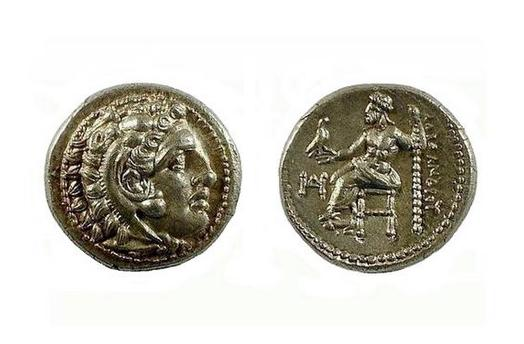
about ancient nomos
Ancient Nomos Art is a museum of galleries exhibiting ancient coins and ancient mint maps. The coin gallery displays the diverse art and history of hand-crafted ancient Greek, Roman, Byzantine, Persian and Medieval coinage. The ancient mints mapping gallery features Greek, Roman, Byzantine, Asia Minor and Medieval mint city regions and territories. Visitor's are welcome to explore, study and enjoy Ancient Nomos Art.

Greek, Miletus – 325 BC
Alexander III
From Ancient Galleries

Obverse: Bust of Herakles wearing a Lion's skin headdress facing right.
Reverse: Zeus seated left holding eagle and sceptre, Miletus monogram to left.
LEGEND SYMBOLS
Obv: Head of Herakles facing right, wearing a lion’s skin headdress. Rev: ΑΛΕΞΑΝΔΡΟΥ to right, Zeus enthroned holding eagle in out stretched right hand and scepter in left hand; Miletus mint monogram in field to left.
The exceptionally artful silver drachm above was issued by Alexander the Great during his lifetime. This exquisitely engraved coin was struck at the Miletos mint, one of Alexander’s principal Asia Minor mints at the time. Alexander began minting coinage in the eastern provinces of Asia Minor after defeating the Persians and gaining control of Tarsos, sometime during 334 BC. His newly issued Asia Minor coin denominations were based on the old Attic standard weights of the eastern Mediterranean and were first struck in the city of Tarsos (see tetradrachm of Tarsos) and then subsequently in the city of Miletos as he expanded territory. The dating of drachm specimens in the name of Alexander, minted with a Miletos monogram, is attributed to after 325 BC, but before 323 BC. These examples are also considered coinage minted during Alexander’s lifetime. Lifetime examples are considered much scarcer than the later posthumous issues because of the short 10 year minting duration. Nevertheless, the first Alexander issue of drachms at the Miletos mint is by far the most extensive of the Alexandrian series, with hoard evidence proving that nearly 100 different obverse dies have been recorded. The initial emission of drachms at the Miletos mint is thought by many numismatists to be the largest single issue of drachms at any of Alexander’s Asia Minor mints. It is also important to note the chronology of Alexander’s Asia Minor coinage. For this, two important dates are used to chronical the dating of Alexander coinage which includes; the year in which Alexander began his Asia Minor campaigns in 343 BC, and the year when Alexander died in 323 BC. Miletos is commonly known by numismatists as a “drachm city,” which is thought to have begun coin production after 325 BC. Alexander issued the Greek drachm in the eastern territories because it most closely resembled the Persian sigloi size and weight (Thompson & Bellinger). At the time, the sigloi type coinage was commonly used in east Asia Minor. Therefore, the drachm would have been a more familiar currency for citizens of the region, as opposed to the much heavier tetradrachm. In addition to familiarity, many believe the Asia Minor mints were also opened to pay returning Greek soldiers who were sent home from Alexander’s army during his eastern campaigns. (CNR Vol. XL, No.2) The silver drachm coin obverse depicts the usual head of Heracles in a lion-skin headdress facing right along with an image of Zeus enthroned facing left on the reverse. By the end of Alexander’s short lifetime, a total of twenty-five ancient mints were opened and producing his coinage including; two in Macedonia (see tetradrachm of Amphipolis), one in Egypt, and twenty-three in Asia Minor.
DOCUMENTATION
Value: Drachm. Metal: AR Silver. Weight: 4.30 grams. Mints: Miletos. Date: 325 – 323 BC.
Attribution: Price 2090; ADM I Series I 86; SNG Alpha Bank 629–32; SNG Saroglos 771.
Legend, Documentation and Attribution
